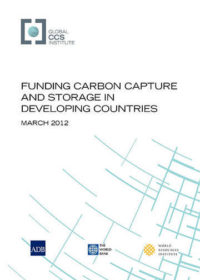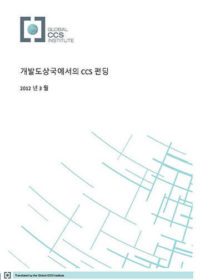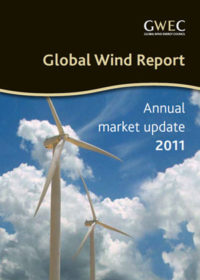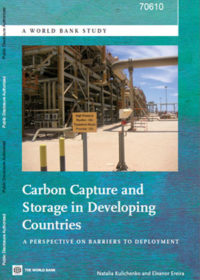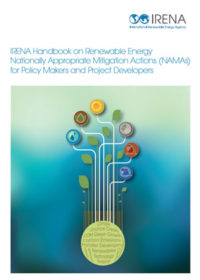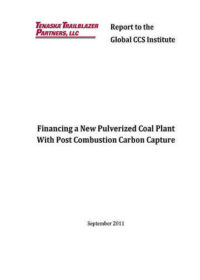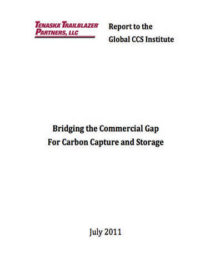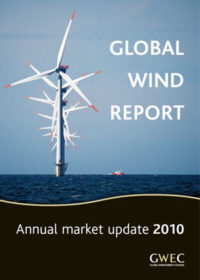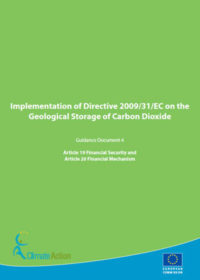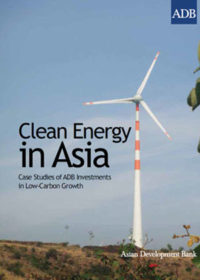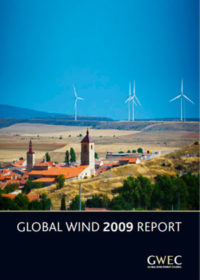Resources
Publications
Our publications, reports and research library hosts over 500 specialist reports and research papers on all topics associated with CCS.
View our Publication Library Disclaimer.
Filter by
Funding carbon capture and storage in developing countries
1st March 2012
Topic(s): Capacity development, Carbon capture use and storage (CCUS), Incentive mechanisms, Project financing
In order for CCS to play its role in reducing global CO2 emissions on a significant scale, it will need to be deployed in developed and developing countries, particularly given that it is expected that all of the net fossil fuel growth (and associated CO2 emissions) will be in developing countries in the coming decades.
While there is a strong climate change case for supporting CCS, there is currently only a relatively weak ‘business case’ for CCS in most developing countries. This report, developed for the Third Clean Energy Ministerial Meeting held in London on 25-26 April 2012, makes recommendations to Ministers on the need for short- and medium-term funding.
Disclaimer
The content within the Global CCS Institute Publications, Reports and Research Library is provided for information purposes only. We make every effort and take reasonable care to keep the content of this section up-to-date and error-free. However, we make no claim as to its accuracy, currency or reliability.
Content and material featured within this section of our website includes reports and research published by third parties. The content and material may include opinions and recommendations of third parties that do not reflect those held by the Global CCS Institute.
개발도상국에서의 CCS 펀딩
1st March 2012
Topic(s): Capacity development, Carbon capture and storage (CCS), Project financing
CCS는 세계 CO2 배출량 감축에 크게 기여할 수 있기 때문에, 현재의 ‘실증’ 단계에서 경제적으로 사용 가능한 기술로 개발될 때까지 후원을 받는 것이 중요하다. 대규모 신재생에너지 프로젝트가 경제적으로 실현 가능할 때까지 자금을 제공받아야 하듯 CCS 또한 후원금이 필요하다. 현재 CCS는 2011년 12월까지 청정개발체체(Clean Development Mechanism) 등 일부 기후변화 재원 자금에서 제외되어 있었기 때문에 자금이 더욱 절실한 상황이다.
Disclaimer
The content within the Global CCS Institute Publications, Reports and Research Library is provided for information purposes only. We make every effort and take reasonable care to keep the content of this section up-to-date and error-free. However, we make no claim as to its accuracy, currency or reliability.
Content and material featured within this section of our website includes reports and research published by third parties. The content and material may include opinions and recommendations of third parties that do not reflect those held by the Global CCS Institute.
Global wind report: annual market update 2011
1st March 2012
Topic(s): Domestic policy, Economics, Project financing, Wind energy
This is the seventh annual report on the status of the global wind industry by the Global Wind Energy Council. It provides a comprehensive snapshot of the global industry, present in 75 countries, with 21 countries having more than 1000 MW installed. The data and analysis for the country profiles in this report have been collected through GWEC’s member associations and companies around the world, as well as from governments and independent analysts.
Disclaimer
The content within the Global CCS Institute Publications, Reports and Research Library is provided for information purposes only. We make every effort and take reasonable care to keep the content of this section up-to-date and error-free. However, we make no claim as to its accuracy, currency or reliability.
Content and material featured within this section of our website includes reports and research published by third parties. The content and material may include opinions and recommendations of third parties that do not reflect those held by the Global CCS Institute.
Carbon capture and storage in developing countries: a perspective on barriers to deployment
1st January 2012
Topic(s): Capacity development, Carbon capture use and storage (CCUS), Domestic policy, Project financing
CCS could have significant impact as a carbon mitigation technology in greenhouse gas emitting industries. Given the nascence of CCS technology, with only eight large-scale integrated projects in the world (Global CCS Institute 2010), significant challenges still must be overcome for large-scale deployment, such as addressing technical issues of integration and scale-up, legal and regulatory requirements to reduce investor risk, policies to create market drivers and mitigate economic impacts, including increases in electricity prices, and financing mechanisms to facilitate investment in the technology.
This report does not provide prescriptive solutions to overcome these barriers, since action must be taken on a country-by-country basis, taking account of different circumstances and national policies. Individual governments should decide their priorities on climate change mitigation and adopt appropriate measures accordingly. The analyses presented in this report may take on added relevance, depending on the future direction of international climate negotiations and domestic legal and policy measures, and how they serve to encourage carbon sequestration. Both international and domestic actions can further incentivise the deployment of CCS and its inclusion in project development. Incentives to promote CCS include adopting climate change policies that could provide revenues for CCS projects, but it is likely that a combination of domestic and international mechanisms will be required, alongside carbon revenues, to kick-start CCS project development and reduce investor risk in developing countries in particular.
This report assesses some of the most important barriers facing CCS deployment within the context of developing and transition economies. The selection of the case studies is based on several criteria, including the level of reliance on fossil fuels for power generation and the level of interconnection of electricity networks. The case studies selected for this analysis are the Balkans and Southern African regions. Many countries within the Balkan region are considered transition economies, a status recognised as different from middle-income and low-income developing countries. However, for the purposes of this report, countries within both regions are referred to as developing countries.
The report presents the results of a techno-economic modelling exercise to investigate the impacts of a number of policies on CCS deployment in the power sector in the Balkan and Southern African regions. The analysis examines the effects of such policies on energy technology portfolios in the two regions, including the level of CCS deployment, the average generation costs, the CO2 emission reductions, and the costs of the policy. Policies considered in the analysis include the introduction of a carbon price (introduced into the model incrementally at the following three levels: US$25/ton CO2, US$50/ton CO2, and US$100/ton CO2) the availability of enhanced hydrocarbon recovery, and technology-specific deployment targets. However, it should be noted that other measures that are not included in the model, but discussed in other sections of the report, could promote the development of CCS, such as government supporting policies, as seen in the United States, United Kingdom, European Union and Australia.
Disclaimer
The content within the Global CCS Institute Publications, Reports and Research Library is provided for information purposes only. We make every effort and take reasonable care to keep the content of this section up-to-date and error-free. However, we make no claim as to its accuracy, currency or reliability.
Content and material featured within this section of our website includes reports and research published by third parties. The content and material may include opinions and recommendations of third parties that do not reflect those held by the Global CCS Institute.
IRENA handbook on renewable energy nationally appropriate mitigation actions (NAMAs) for policy makers and project developers
1st January 2012
Topic(s): Domestic policy, Incentive mechanisms, Project financing, Renewables
This Handbook focuses on the role that Nationally Appropriate Mitigation Actions (NAMAs) can play in promoting renewable energy in developing countries. The concept of NAMAs was developed in the negotiations carried out under the United Nations Framework Convention on Climate Change (UNFCCC) to denote planned, voluntary greenhouse gas (GHG) mitigation actions in countries that do not have a legally binding emissions commitment. Notifying a NAMA thus practically means putting a UNFCCC-backed label on national development activities with mitigation effects. Renewable energy, being carbon dioxide-free, is a perfect candidate for a NAMA as it combines development benefits through the provision of energy with GHG reduction.
Disclaimer
The content within the Global CCS Institute Publications, Reports and Research Library is provided for information purposes only. We make every effort and take reasonable care to keep the content of this section up-to-date and error-free. However, we make no claim as to its accuracy, currency or reliability.
Content and material featured within this section of our website includes reports and research published by third parties. The content and material may include opinions and recommendations of third parties that do not reflect those held by the Global CCS Institute.
Financing a new pulverized coal plant with post combustion carbon capture
1st September 2011
Topic(s): CO2 capture, Project financing
Tenaska, in its role as developer, will be responsible for obtaining financing for the project. Tenaska has raised approximately US$11.4 billion in aggregate financing, including US$4.7 billion in bank facilities, US$3.0 billion in capital market transactions and US$3.7 billion in corporate facilities.
This report discusses the issues associated with financing the Trailblazer project. Although a detailed discussion of the revenue gap currently facing the project was provided in the Global CCS Institute report entitled Bridging the Commercial Gap for Carbon Capture and Storage dated July 2011, a recap will be provided in this report. This report also discusses the financing considerations this and other large carbon capture and storage (CCS) projects will face, as well as factors that can mitigate financing risks. Finally, the report outlines Tenaska’s plan for financing the project.
Disclaimer
The content within the Global CCS Institute Publications, Reports and Research Library is provided for information purposes only. We make every effort and take reasonable care to keep the content of this section up-to-date and error-free. However, we make no claim as to its accuracy, currency or reliability.
Content and material featured within this section of our website includes reports and research published by third parties. The content and material may include opinions and recommendations of third parties that do not reflect those held by the Global CCS Institute.
Bridging the commercial gap for carbon capture and storage
1st July 2011
Topic(s): Carbon capture use and storage (CCUS), CO2 capture, Project financing
Tenaska share their analysis of the commercial market factors which drive their project. This project plans to sell electricity into the Electricity Reliability Council of Texas (ERCOT) energy market, capture over five million tonnes of CO2 per year, and sell it into the Permian Basin Enhanced Oil Recovery (EOR) market both of which have large unmet demand. This report discusses the economic realities facing the Trailblazer Project to incorporate a commercial-scale carbon dioxide capture plant into its initial design. It reviews the markets for both electricity and carbon dioxide, and discusses the governmental support that may be needed to bridge the gap between the Project’s likely costs and revenues.
Disclaimer
The content within the Global CCS Institute Publications, Reports and Research Library is provided for information purposes only. We make every effort and take reasonable care to keep the content of this section up-to-date and error-free. However, we make no claim as to its accuracy, currency or reliability.
Content and material featured within this section of our website includes reports and research published by third parties. The content and material may include opinions and recommendations of third parties that do not reflect those held by the Global CCS Institute.
Global wind report: annual market update 2010
1st April 2011
Topic(s): Domestic policy, Project financing, Wind energy
This is the sixth annual report on the status of the global wind industry by the Global Wind Energy Council. It provides a comprehensive snapshot of this global industry - present in 80 countries. The data and country profiles for this report have been collected through GWEC’s member associations and companies around the world, as well as from other analysts and government contacts.
Disclaimer
The content within the Global CCS Institute Publications, Reports and Research Library is provided for information purposes only. We make every effort and take reasonable care to keep the content of this section up-to-date and error-free. However, we make no claim as to its accuracy, currency or reliability.
Content and material featured within this section of our website includes reports and research published by third parties. The content and material may include opinions and recommendations of third parties that do not reflect those held by the Global CCS Institute.
CCS demonstration in developing countries: priorities for a financing mechanism for carbon dioxide capture and storage
1st April 2011
Topic(s): Carbon capture use and storage (CCUS), Project financing
Existing financing for carbon capture and storage (CCS) is grossly insufficient to enable demonstration projects in developing countries. The few available funds are either spread over the full array of low-carbon technologies, or fall short of the magnitude or the mandate needed to propel commercial-scale CCS demonstrations forward. Current carbon offset mechanisms are not sufficient to spur CCS deployment in developing countries in today’s context either. Overall, existing CCS financing mechanisms help grow capacity, but their support is insufficient to leverage enough funding from capital markets to implement projects in a non-OECD context.
Disclaimer
The content within the Global CCS Institute Publications, Reports and Research Library is provided for information purposes only. We make every effort and take reasonable care to keep the content of this section up-to-date and error-free. However, we make no claim as to its accuracy, currency or reliability.
Content and material featured within this section of our website includes reports and research published by third parties. The content and material may include opinions and recommendations of third parties that do not reflect those held by the Global CCS Institute.
Implementation of Directive 2009/31/EC on the Geological Storage of Carbon Dioxide. Guidance document 4: article 19 financial security and article 20 financial mechanism
29th March 2011
Topic(s): Carbon capture use and storage (CCUS), Project financing
This document is part of a series of four guidance documents issued by the European Commission, each covering different aspects of the geological storage of CO2. This document provides guidance on financial security and financial mechanism.
Disclaimer
The content within the Global CCS Institute Publications, Reports and Research Library is provided for information purposes only. We make every effort and take reasonable care to keep the content of this section up-to-date and error-free. However, we make no claim as to its accuracy, currency or reliability.
Content and material featured within this section of our website includes reports and research published by third parties. The content and material may include opinions and recommendations of third parties that do not reflect those held by the Global CCS Institute.
Clean energy in Asia: case studies of ADB investments in low-carbon growth
5th July 2010
Topic(s): Project financing, Renewables
This publication features ten stories from clean energy projects implemented in six Asian countries. It describes the Asian Development Bank’s efforts to change the face of energy lending into a cleaner and more sustainable route toward energy security and low-carbon growth. The case studies show how developing Asia is contributing to the global effort to identify and implement solutions to combat climate change.
Disclaimer
The content within the Global CCS Institute Publications, Reports and Research Library is provided for information purposes only. We make every effort and take reasonable care to keep the content of this section up-to-date and error-free. However, we make no claim as to its accuracy, currency or reliability.
Content and material featured within this section of our website includes reports and research published by third parties. The content and material may include opinions and recommendations of third parties that do not reflect those held by the Global CCS Institute.
Global wind 2009 report
1st March 2010
Topic(s): Domestic policy, Economics, Project financing, Wind energy
This is the fifth annual report on the status of the global wind industry by the Global Wind Energy Council. It provides a comprehensive snapshot of this global industry - present in more than 70 countries. The data and country profiles for this report have been collected through GWEC’s member associations and companies around the world, as well as from other analysts and government contacts.
Disclaimer
The content within the Global CCS Institute Publications, Reports and Research Library is provided for information purposes only. We make every effort and take reasonable care to keep the content of this section up-to-date and error-free. However, we make no claim as to its accuracy, currency or reliability.
Content and material featured within this section of our website includes reports and research published by third parties. The content and material may include opinions and recommendations of third parties that do not reflect those held by the Global CCS Institute.
